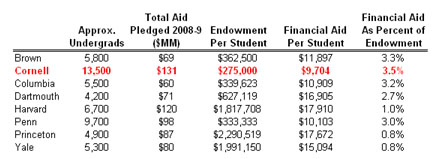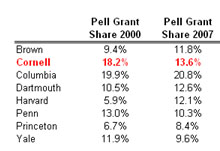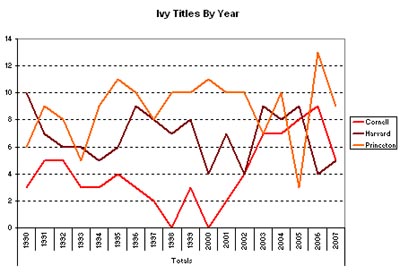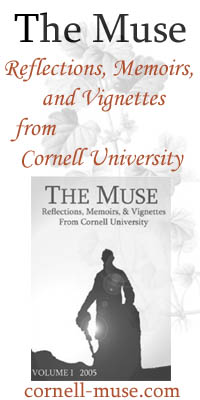 | ||
Archives
|
February 2008
Is Cornell The Most Generous Ivy?
Amidst the recent flurry of announcements regarding financial aid policies, it may be hard to see the forest through the trees, especially if one solely relies on the gushing press releases published by each school's own public relations machine. But a careful analysis of the recent financial aid announcements - considered within the context of each school's respective financial well-being - indicates that Cornell is the Ivy most generous with its money. For the time being, I've limited this analysis to schools within the Ivy League. Although Cornell definitely overlaps with a lot more schools than just the Ivy schools for a variety of reasons, the figures for these schools tend to be a lot more readily accessible than for other schools. Moreover, there has been a lot of interest recently in how financial aid packages will impact the competitive parity of the Ancient Eight. The first table lists each school's estimated financial aid payout in 2008-9 after all of the recent policy changes are adopted. (Sources found after the jump.) It compares the average financial aid package per undergraduate and total undergraduate financial aid relative to the institution's endowment. While a comparison to a school's endowment isn't ideal for a bunch of reasons, its the best quick and easy measure of a school's financial resources available. What becomes pretty clear is that in 2008-9 Cornell will be outspending every Ivy on financial aid -- both in absolute terms and relative to its endowment. But it also lags the League in terms of aid spent per student, meaning Cornell's average financial aid package is not as attractive as its peers on the playing field.  In this light, Cornell's policy is unequivocally the most generous in the League -- Day Hall is dedicating the highest amount of resources to ensure that students can afford a world-class education. It's pretty evident that there are three tiers in the League. Harvard, Yale, and Princeton -- the Big Three -- offer the most aid per student, but also pledge the least amount of resources relative to their endowment. Meanwhile, Brown, Cornell, Columbia, and Penn generally offer the least amount of aid per student, with packages that generally can't compete with the Big Three, but need to dedicate three times as much of their financial resources to do so. Dartmouth is squeezed in the middle; spending just as much per student as the Big Three, but having to dedicate almost three times as much of its resources to do so. The one thing missing in this analysis is the financial well-being of the student body. The more socio-economically diverse the student body is, the more the University's resources will be stretched to provide aid. Cornell has always prided itself in educating a socio-economically diverse student body. Just look at the share of students on federal Pell grants. This diversity is part of the institution's founding principles, and it's fair to say that, more so than any of its Ivy brethren, Cornell has served as an engine of American meritocracy -- just look at the Washington Monthly's annual ranking of colleges.  But this fact has strapped Cornell's resources even more. And it has now become clear that amidst the recent financial aid arms race, Cornell has found itself becoming less socioeconomically diverse. It's still the second-most diverse school in the League, and I suspect Columbia's numbers may be skewed by its General Studies school. The Daily Sun ran an article on this very point on Friday. But its analysis was a bit misleading and unbalanced, focusing on the absolute number of Pell grants awarded, and not the share of students receiving these grants. We're still educating more students on Pell grants than Harvard, Yale, and Princeton combined, and have a higher share of recipients. Still, the numbers are sobering, and indicate that competitive pressures are changing the face and spirit of Cornell. Ezra's university may have gone "no-loan" but it still hasn't gone "tuition free". And the perverse economics of higher education -- with competing interests for top facilities, top faculty, top students, and top sports teams -- suggests that this trend isn't going away anytime soon. If we want Cornell to be competitive for the best and brightest students going forward, either us alumni or the State of New York are going to have to start paying up. Day Hall is already stretched too thin. Matthew Nagowski | February 23, 2008 (#) Whither the Ivy League? Josh Perlin finishes his three-part series on financial aid and athletics recruiting today by suggesting that some of the other Ivies may be "creatively financing" certain athletes financial aid packages, looking beyond simple need-based formulas: Penn Director of Athletics Steve Bilsky declined to comment on his school’s specific practices. “There are variables that allow some ability to be subjective in [matching financial aid packages],” Bilsky said. “[Penn does] not have the resources to match Harvard’s policy. … So, our coaches can’t go out and say, whatever Harvard does, we will match your package. That would be a short-term solution to say that. But that would cost so much, that my guess would be most of the schools in the league won’t do that and can’t do that.” And in an accompanying opinion piece, Josh ponders the future of the Ivy League: Competitive balance isn’t about two teams: it’s about every team and school in the league. Cornell has a grand total of zero championships in 2007-08, and is on pace to take only two through the winter season. What’s more, after a record pace of titles from 2001-06, Cornell hit a five-year low last year. So, between last year and this year, it’s pretty safe to say Cornell is on the decline … I won’t speculate why. It's pretty clear that changing financial aid policies are putting more stress on the League than at any other point in the last three decades -- certainly since the AI system was adopted. And there has been a lot of active, cerebral discussion stemming out of Josh's articles across the Ivy League. I still maintain that Cornell might be better served in a conference such as the Big Ten. After all, Cornell's a big, diverse, multi-headed university, and scholarship football would add a lot to the student and alumni experience without negatively impacting the overall academic caliber of University like it presumably would at a Dartmouth or a Brown. If Stanford and Northwestern, Michigan and Berkeley can do it, why couldn't we? Moreover, Cornell is really quite a different place than the rest of the Ivies, and we could certainly afford to forgo some of the student body who only chose to attend Cornell due to the athletic association in which it happens to compete. On the other hand, the ideals of the Ivy League are very attractive. The notion of a true scholar-athlete and the aim for competitive parity across schools is really what makes the Ivy League exemplary. If anything, Josh's articles should be a wake-up call to the University community, and in particular, its alumni base. If we value the principles of the Ivy League, and we value the experiences of our Cornell education, we should be doing more to help contribute financially to Cornell's mission. After all, it is only due to the philanthropy of others that we have benefited as much as we have from our Cornell education. Matthew Nagowski | February 22, 2008 (#) Peeking Under The Sun's Hood I thought I'd take a break from slyly linking to my own stories under the "In Brief" column and failing miserably to lock down three potential MetaEzra Q&A interviews in a row to give another shoutout to The Sun for what promises to be a cool online feature: the CMYK blog, a peek into the paper's design process. Munier Salem, a compet for assistant design editor, starts out his inaugural post by reminding me of my own dorky past: OK, mine was a history project called The Tenochtitlan Post whose stories (dated November 1519) had headlines like "Quetzalcoatl Sighted, Lavished With Gifts." But that obsession with journalistic style and convention, even down to a believable layout, foreshadowed a longer infatuation with newsprint (and news bits). Salem illustrates that some of the most innovative ideas come from ambitious editors in training and highlights the unsung heroes of the production process: the zombies who hunch over Photoshop and InDesign at insane hours of the night to make the next day's newsprint look presentable, clean and attractive. And judging from The Sun's daily online PDFs of the front and back pages, the design has steadily improved over the past year or two, along with the photographs. Here's hoping for a guided tour of what's in store for the future of Ithaca's first morning newspaper. Andy Guess | February 20, 2008 (#) Brains, Brawn, and Financial Aid Sun Sports Editor Josh Perlin is running an outstanding article on the role that aggressive financial aid policies by Harvard and others is playing in Cornell's own athletics programs: A number of cases across men's and women's teams were confirmed where differences in aid packages between Cornell and other Ivies amounted to tens of thousands of dollars per year. Noel stated that the information obtained by The Sun was not a series of atypical cases, and that significant discrepancies have come up across a majority of Cornell's 36 athletics teams this year. "This is a problem that's not isolated to specific sports," Noel said. "Without a doubt, there are multiple situations across multiple teams where recruits are being offered financial aid packages at other Ivies that are not allowable by our policies." Perlin's article today is the first of three parts, and we're eagerly waiting to read the rest. While we suspect that financial aid packages will have a sizable impact on parity within Ivy League athletics going forward, recent history suggests that Cornell's relatively weak financial position hasn't affected the caliber of its athletic programs within the Ivy League yet. And in truth, financial aid may not matter as much as coaching, support from the administration, and facilities. In fact, the last couple of years seem to have been a bona fide golden age for Cornell sports. Within the Ivy League, there have always been two perennial powers capturing a disproportionate amount of Ivy titles across all sports -- Harvard and Princeton. But Cornell appears to have made strides in recent years:  Note: This graph is based on statistics I quickly compiled from IvyLeagueSports.com. It shouldn't be considered to be completely accurate. If anybody has a more definitive source of data, please let me know. Of course, the increasingly competitive nature of need-based financial aid programs is impacting Cornell's admissions pool far beyond athletics. The same implications for varsity athletes can be made for all students. And due to Cornell's relatively weak financial standing when compared to the rest of the Ivy League, combined with the Ivy group's strict policy forbidding any sort of merit aid, Cornell is really being placed between a rock and a hard place. Why? Because our Ivy peers are able to offer superior need-based financial aid. And our non-Ivy peers are able to offer merit-based aid for both athletics and standout students. For instance, Northwestern just started a merit-based aid program and Washington University in St. Louis is famous for providing merit based aid to top students. Meanwhile, places like Duke and Johns Hopkins offer athletic scholarships in sports like lacrosse, whereas Cornell does not. The one factor that works in Cornell's favor, however, is that the admissions process for Cornell tends to be a bit less competitive than the admissions process at some of the other Ivies. This means that we might be able to cast a larger net and recruit farther down the academic spectrum for athletes. But then there are always the anecdotes about Penn recruiting the basketball player or Harvard recruiting the football player with sub-1100 SAT scores. That being said, this Yale Herald piece does an excellent job describing how the league regulates the recruitment of athletes, and the net effect doesn't seem to be that large. After all, if it did have an impact, maybe Cornell would have had a more successful football team in recent years. Matthew Nagowski | February 19, 2008 (#) Big Red Basketball
Cornell's a hockey school. We know. But with the hockey team failing to assert themselves at a national level over the last two years, it is hard not to turn our attention over to the high quality squeakball being played next door at Newman Arena. The Carnelian and White are leading the Ivy League half way through the season with a 7-0 record, two games ahead of second place Brown. And while they aren't nearly as close to capturing a national title as recent hockey, wrestling, or lacrosse teams, what's notable is that for the first time in twenty years it looks like a team other than Penn or Princeton will capture the Ivy Title. The last team other than the Ps to win it? That would be Cornell in 1988. With such a young team (two of Cornell's best players, Louis Dale and Ryan "son of an NBA coach" Wittman are sophomores) all signs indicate a sea change occurring in Ivy Basketball these days, as Penn and Princeton will no longer hold all of the recruiting prowess in the league. So without putting the cart before the horse, there's a possibility that us alums will be able to bet on the Big Red in our office pools come March Madness. And some mid-season polls have speculated that Cornell might even be able to capture an improbable 13 seed. With this possibility comes student interest -- Cornell students have dubbed themselves the "Newman Nation" to parallel the "Lynah Faithful", as well as national media attention -- the Ivy League winners always getting national press due to the philosophy of putting the "student" back into "student-athlete". Cornell already garnered attention when they put up a fight against No. 2 Duke at Cameron Indoor Stadium in January. But now, the NYTimes is following the team this weekend in a rather enjoyable series of blog posts. Here's an excerpt about Cornell's stunning 72-71 come from behind victory over Harvard last night: That’s exactly what the Big Red got, as they pulled out a stunning victory in beating Harvard, 72-71. Harvard led by 5 points with just over 30 seconds remaining, but melted down in the waning moments of what was one of the best finishes in a basketball game all season. “That was as good a college basketball game you can have,” a relieved Randy Wittman said in the stands after the game. “I don’t care what the level is.” Wittman is the coach of the Minnesota Timberwolves and his son Ryan is Cornell’s top player. For those interested in following the team through the rest of Ivy play, and hopefully beyond, we recommend The Cornell Basketball Blog, a nice supplement to the mostly hockey-oriented eLynah. Finally, we would be amiss if we didn't mention the women's team, which after a blasting of Harvard last night also finds itself alone atop of the Ivy League. The Cornell women's team has never won an Ivy Championship in basketball. They play against second-place Dartmouth tonight in hopes of cementing their lead in the conference. Matthew Nagowski | February 16, 2008 (#) |
-- WSJ: Cornell Wins NYC Tech Campus Bid (EBilmes) -- Barrier Update: City Approves Nets (DJost) -- Big Red Cymbal Guy (Nagowski) -- New York Times Survey on Campus Recruiting is Flawed (KScott) -- Barrier Update: Legal precedent suggests City of Ithaca will not be held liable for gorge suicide (DJost) -- Despite MSG Loss, Big Potential for Big Red Hockey (EBilmes) -- City Council Will Vote on Suicide Nets (DJost) -- An Encounter on the Upper East Side (Nagowski) -- Showing Off Your School Spirit (Nagowski) -- Chipotle Ithaca? (KScott) -- Cornell at the ING NYC Marathon (KScott) -- Crossing Over a Fine Line: Commercial Activity on Campus (KScott) -- Milstein's Downfall (Nagowski) -- Can any Cornell-associated organization really be independent of the University? (Nagowski) -- Slope Media Revisited (EBilmes) -- Slope Media Group Approved for Byline Funding (KScott) -- Occupy AEM? (KScott) -- New campus pub to be good for both Greeks and non-Greeks (Nagowski) -- Gagging the Election (Nagowski) -- The Changing Structure of Rush Week (Nagowski) -- Ivy League Humility in the Midwest (EBilmes) -- Of Median Grades and Economics Minors (Nagowski) -- Homecoming Recap (Nagowski) -- My Cornell Bookshelf (Nagowski) -- The Sun's Opinion Section Has Suddenly Gotten Good (Nagowski) -- Remembering the 11th (Nagowski) -- Cornellian Tapped as Top Economic Advisor (Nagowski) -- Cutting Pledging, and the Good Which Comes With It (EBilmes) -- Why Cornell Should Not Close Fall Creek Gorge (Nagowski) -- Welcome to the Class of 2015 (Nagowski)  |